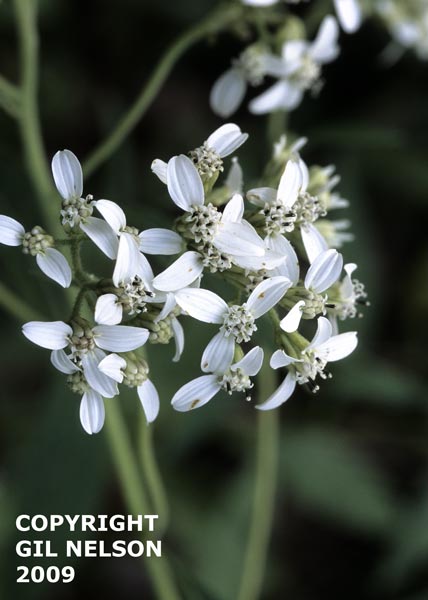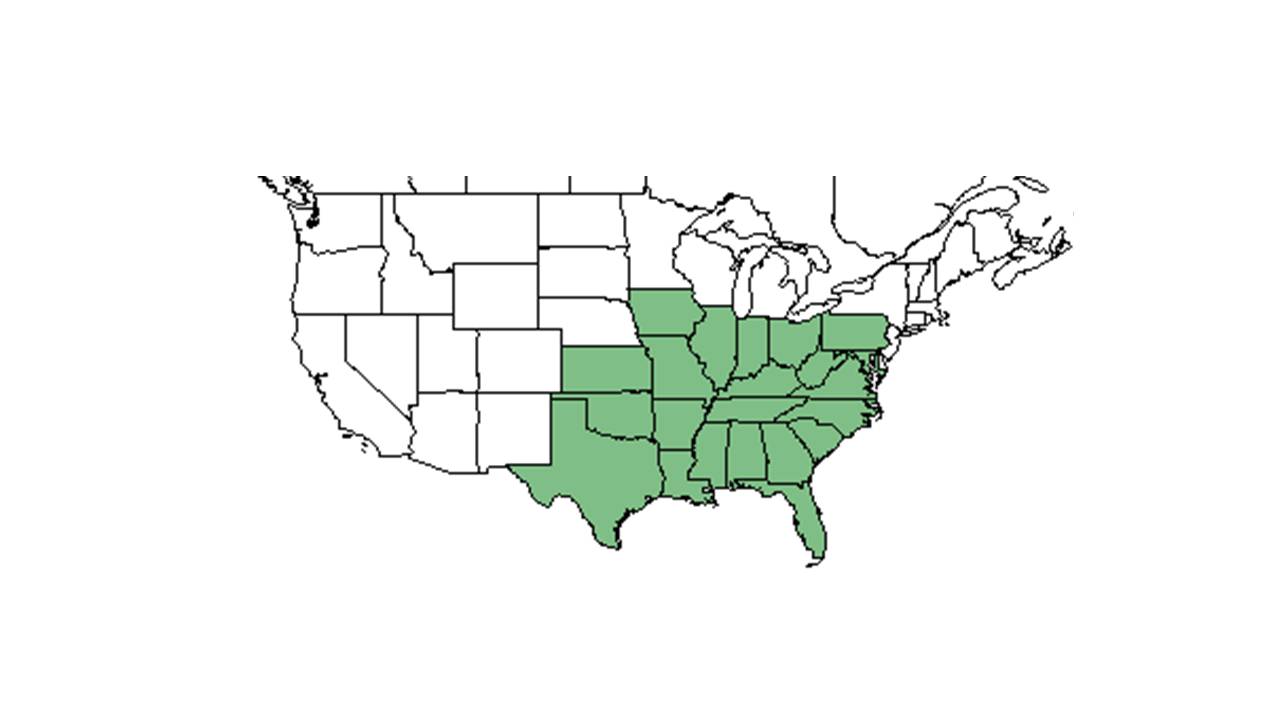Difference between revisions of "Verbesina virginica"
KatieMccoy (talk | contribs) |
HaleighJoM (talk | contribs) (→Ecology) |
||
| (18 intermediate revisions by 9 users not shown) | |||
| Line 15: | Line 15: | ||
| binomial_authority = L. | | binomial_authority = L. | ||
| range_map = VERB_VIRG_dist.jpg | | range_map = VERB_VIRG_dist.jpg | ||
| − | | range_map_caption = Natural range of ''Verbesina virginica'' from USDA NRCS [http:// | + | | range_map_caption = Natural range of ''Verbesina virginica'' from USDA NRCS [http://plants.usda.gov/core/profile?symbol=VEVI3 Plants Database]. |
}} | }} | ||
| − | Common | + | Common names: White crownbeard, Common Frostweed |
==Taxonomic notes== | ==Taxonomic notes== | ||
| + | Synonym: ''Phaethusa laciniata'' (Poiret) Small; ''Phaethusa virginica'' (Linnaeus) Britton.<ref>Weakley, A.S. 2015. Flora of the southern and mid-atlantic states. Working Draf of 21 May 2015. University of North Carolina at Chapel Hill, Chapel Hill, North Carolina.</ref> | ||
| + | |||
| + | Variety: ''Verbesina virginica'' Linnaeus var. ''laciniata'' (Poiret) A. Gray.<ref>Weakley, A.S. 2015. Flora of the southern and mid-atlantic states. Working Draf of 21 May 2015. University of North Carolina at Chapel Hill, Chapel Hill, North Carolina.</ref> | ||
| + | |||
==Description== | ==Description== | ||
<!-- Basic life history facts such as annual/perrenial, monoecious/dioecious, root morphology, seed type, etc. --> | <!-- Basic life history facts such as annual/perrenial, monoecious/dioecious, root morphology, seed type, etc. --> | ||
A description of ''Verbesina virginica'' is provided in [http://www.efloras.org/florataxon.aspx?flora_id=1&taxon_id=242417427 The Flora of North America]. | A description of ''Verbesina virginica'' is provided in [http://www.efloras.org/florataxon.aspx?flora_id=1&taxon_id=242417427 The Flora of North America]. | ||
| + | ==Distribution== | ||
| + | ''Verbesina virginica'' is endemic to an area from southern South Carolina to peninsular Florida, but the majority is found in Florida.<ref>Sorrie, B. A. and A. S. Weakley 2001. Coastal Plain valcular plant endemics: Phytogeographic patterns. Castanea 66: 50-82.</ref> | ||
| − | |||
==Ecology== | ==Ecology== | ||
===Habitat=== <!--Natural communities, human disturbed habitats, topography, hydrology, soils, light, fire regime requirements for removal of competition, etc.--> | ===Habitat=== <!--Natural communities, human disturbed habitats, topography, hydrology, soils, light, fire regime requirements for removal of competition, etc.--> | ||
| − | ''Verbesina virginica'' can be found in sandy loams of mixed hardwoods; floodplains; mixed oak-pine woodlands; live oak woods; sandy dunes; slash pinewoods; open calcareous bluffs; scrubs; mesic woodlands of shallow ravines; clay soils of mixed hardwood/cabbage palm communities; calcareous banks of rivers; deciduous upland woods; wet hammocks; swamps; near brackish water; wooded pasture with exposed limestone; low swamp with alluvial soil; pine-oak-hickory woodlands; limestone glades; cedar glade near shallow stream; and wet pine flatwoods | + | ''Verbesina virginica'' can be found in sandy loams of mixed hardwoods; floodplains; mixed oak-pine woodlands; live oak woods; sandy dunes; slash pinewoods; open calcareous bluffs; scrubs; mesic woodlands of shallow ravines; clay soils of mixed hardwood/cabbage palm communities; calcareous banks of rivers; deciduous upland woods; wet hammocks; swamps; near brackish water; wooded pasture with exposed limestone; low swamp with alluvial soil; pine-oak-hickory woodlands; limestone glades; cedar glade near shallow stream; and wet pine flatwoods.<ref name="FSU Herbarium">Florida State University Robert K. Godfrey Herbarium database. URL: [http://herbarium.bio.fsu.edu http://herbarium.bio.fsu.edu]. Last accessed: July 2015. Collectors: Loran C. Anderson, Kathy Craddock Burks, Robert Kral, Robert K. Godfrey, M. R. Darst, Victoria I. Sullivan, R. E. Perdue, Jr., Richard S. Mitchell, Robert L. Lazor, Jean W. Wooten, Cecil R Slaughter, Marc Minno, George R. Cooley, R. J. Eaton, James D. Ray, Jr., James R. Burkhalter, R. M. Eilers, Andre F. Clewell, J. B. Nelson, S. D. Todd, Delzie Demaree, H. F L. Rock, Robert Runyon, James W. Hardin, J. Mendell, B. C. Tharpe, Fred A. Barkley, J. Haesloop, Sidney McDaniel, Paul L. Redfearn, Jr., R. A. Pursell, W. M. Longnecker, J. P. Gillespie, Lester F. Ward, Harry E. Ahles,, C. L. Lundell, John W. Thieret, Norlan C. Henderson, K. E. Blum, W. D. Reese, O. Hester, A. E. Radford, C. L. Lundell, Amelia Lundell, V. L. Cory, R. Komarek, R. A. Norris. States and Counties: Alabama: Limestone. Arkansas, Hot Springs, Howard, Lawrence, Marion, Polk, Yell. Florida: Brevard, Clay, Dade, Dixie, Escambia, Franklin, Gadsden, Hernando, Hillsborough, Holmes, Jackson, Jefferson, Lee, Leon, Liberty, Osceola, Pinellas, St. John, Taylor, Wakulla, Walton. Georgia: Grady, Thomas, Walker. Kentucky: Jessamine. Louisiana: Iberia, Lafayette, Ouachita. Mississippi: Chickasaw, Coahoma, Hancock, Jackson. Missouri: Douglas, Franklin, Stone. South Carolina: Charleston, Pickens. Tennessee: Davidson, Rutherford, Sumner. Texas: Cameron, Dallas, Gonzales, Hays, Hidlago, Somervell. Compiled by Tall Timbers Research Station and Land Conservancy.</ref> |
| − | Associated species include ''Melanthera nivea, Myrica cerifera, Baccharis, Polymnia, Sabal, Quercus, Schinus, Desmodium ochroleucum, D. rotundifolium Rhynchosia, Rhus aromatica, Polymnia uvedalia, Melanthera nivea'', and ''Calyptocarpus'' | + | Associated species include ''Melanthera nivea, Myrica cerifera, Baccharis, Polymnia, Sabal, Quercus, Schinus, Desmodium ochroleucum, D. rotundifolium Rhynchosia, Rhus aromatica, Polymnia uvedalia, Melanthera nivea'', and ''Calyptocarpus.''<ref name="FSU Herbarium"/> |
| + | ===Phenology=== <!--Timing off flowering, fruiting, seed dispersal, and environmental triggers. Cite PanFlora website if appropriate: http://www.gilnelson.com/PanFlora/ --> | ||
| + | ''V. virginica'' has been observed to flower March through December with peak inflorescence in September and fruit September through November.<ref name="FSU Herbarium"/><ref>Nelson, G. [http://www.gilnelson.com/ PanFlora]: Plant data for the eastern United States with emphasis on the Southeastern Coastal Plains, Florida, and the Florida Panhandle. www.gilnelson.com/PanFlora/ Accessed: 15 DEC 2016</ref> | ||
| + | <!--===Seed dispersal===--> | ||
| + | <!--===Seed bank and germination===--> | ||
| + | <!--===Fire ecology===--> <!--Fire tolerance, fire dependence, adaptive fire responses--> | ||
| + | <!--===Pollination===--> | ||
| + | <!--===Herbivory and toxicology=== <!--Common herbivores, granivory, insect hosting, poisonous chemicals, allelopathy, etc.--> | ||
| + | <!--===Diseases and parasites===--> | ||
| − | == | + | ==Conservation, cultivation, and restoration== |
| − | |||
| − | == | + | ==Cultural use== |
| − | |||
| − | |||
| − | |||
| − | |||
| − | |||
| − | |||
| − | |||
==Photo Gallery== | ==Photo Gallery== | ||
| + | <gallery widths=180px> | ||
| + | </gallery> | ||
==References and notes== | ==References and notes== | ||
Latest revision as of 17:20, 18 July 2022
| Verbesina virginica | |
|---|---|

| |
| Photo taken by Gil Nelson | |
| Scientific classification | |
| Kingdom: | Plantae |
| Division: | Magnoliophyta – Flowering plants |
| Class: | Magnoliopsida – Dicotyledons |
| Order: | Asterales |
| Family: | Asteraceae ⁄ Compositae |
| Genus: | Verbesina |
| Species: | V. virginica |
| Binomial name | |
| Verbesina virginica L. | |

| |
| Natural range of Verbesina virginica from USDA NRCS Plants Database. | |
Common names: White crownbeard, Common Frostweed
Contents
Taxonomic notes
Synonym: Phaethusa laciniata (Poiret) Small; Phaethusa virginica (Linnaeus) Britton.[1]
Variety: Verbesina virginica Linnaeus var. laciniata (Poiret) A. Gray.[2]
Description
A description of Verbesina virginica is provided in The Flora of North America.
Distribution
Verbesina virginica is endemic to an area from southern South Carolina to peninsular Florida, but the majority is found in Florida.[3]
Ecology
Habitat
Verbesina virginica can be found in sandy loams of mixed hardwoods; floodplains; mixed oak-pine woodlands; live oak woods; sandy dunes; slash pinewoods; open calcareous bluffs; scrubs; mesic woodlands of shallow ravines; clay soils of mixed hardwood/cabbage palm communities; calcareous banks of rivers; deciduous upland woods; wet hammocks; swamps; near brackish water; wooded pasture with exposed limestone; low swamp with alluvial soil; pine-oak-hickory woodlands; limestone glades; cedar glade near shallow stream; and wet pine flatwoods.[4]
Associated species include Melanthera nivea, Myrica cerifera, Baccharis, Polymnia, Sabal, Quercus, Schinus, Desmodium ochroleucum, D. rotundifolium Rhynchosia, Rhus aromatica, Polymnia uvedalia, Melanthera nivea, and Calyptocarpus.[4]
Phenology
V. virginica has been observed to flower March through December with peak inflorescence in September and fruit September through November.[4][5]
Conservation, cultivation, and restoration
Cultural use
Photo Gallery
References and notes
- ↑ Weakley, A.S. 2015. Flora of the southern and mid-atlantic states. Working Draf of 21 May 2015. University of North Carolina at Chapel Hill, Chapel Hill, North Carolina.
- ↑ Weakley, A.S. 2015. Flora of the southern and mid-atlantic states. Working Draf of 21 May 2015. University of North Carolina at Chapel Hill, Chapel Hill, North Carolina.
- ↑ Sorrie, B. A. and A. S. Weakley 2001. Coastal Plain valcular plant endemics: Phytogeographic patterns. Castanea 66: 50-82.
- ↑ 4.0 4.1 4.2 Florida State University Robert K. Godfrey Herbarium database. URL: http://herbarium.bio.fsu.edu. Last accessed: July 2015. Collectors: Loran C. Anderson, Kathy Craddock Burks, Robert Kral, Robert K. Godfrey, M. R. Darst, Victoria I. Sullivan, R. E. Perdue, Jr., Richard S. Mitchell, Robert L. Lazor, Jean W. Wooten, Cecil R Slaughter, Marc Minno, George R. Cooley, R. J. Eaton, James D. Ray, Jr., James R. Burkhalter, R. M. Eilers, Andre F. Clewell, J. B. Nelson, S. D. Todd, Delzie Demaree, H. F L. Rock, Robert Runyon, James W. Hardin, J. Mendell, B. C. Tharpe, Fred A. Barkley, J. Haesloop, Sidney McDaniel, Paul L. Redfearn, Jr., R. A. Pursell, W. M. Longnecker, J. P. Gillespie, Lester F. Ward, Harry E. Ahles,, C. L. Lundell, John W. Thieret, Norlan C. Henderson, K. E. Blum, W. D. Reese, O. Hester, A. E. Radford, C. L. Lundell, Amelia Lundell, V. L. Cory, R. Komarek, R. A. Norris. States and Counties: Alabama: Limestone. Arkansas, Hot Springs, Howard, Lawrence, Marion, Polk, Yell. Florida: Brevard, Clay, Dade, Dixie, Escambia, Franklin, Gadsden, Hernando, Hillsborough, Holmes, Jackson, Jefferson, Lee, Leon, Liberty, Osceola, Pinellas, St. John, Taylor, Wakulla, Walton. Georgia: Grady, Thomas, Walker. Kentucky: Jessamine. Louisiana: Iberia, Lafayette, Ouachita. Mississippi: Chickasaw, Coahoma, Hancock, Jackson. Missouri: Douglas, Franklin, Stone. South Carolina: Charleston, Pickens. Tennessee: Davidson, Rutherford, Sumner. Texas: Cameron, Dallas, Gonzales, Hays, Hidlago, Somervell. Compiled by Tall Timbers Research Station and Land Conservancy.
- ↑ Nelson, G. PanFlora: Plant data for the eastern United States with emphasis on the Southeastern Coastal Plains, Florida, and the Florida Panhandle. www.gilnelson.com/PanFlora/ Accessed: 15 DEC 2016